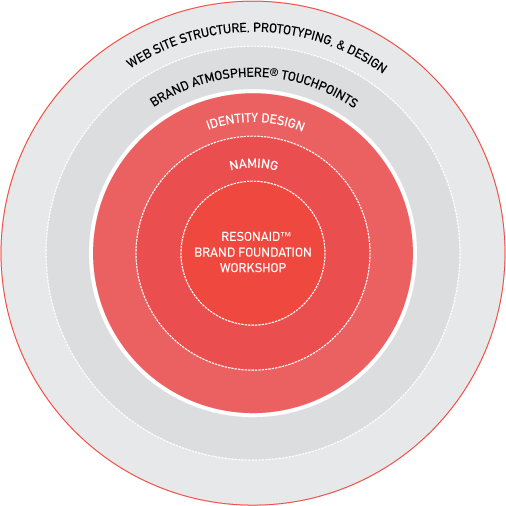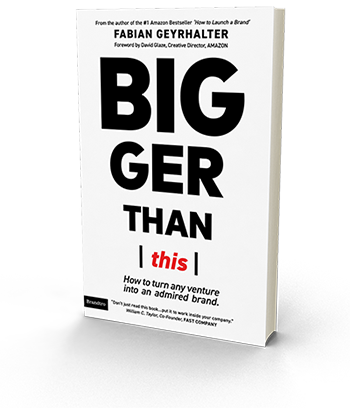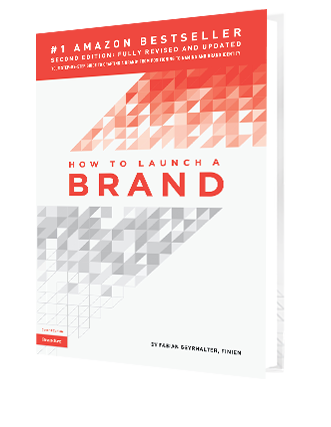Blog
Kill Your Brand In Order To Create It
It’s not quite as harsh as it sounds, but yes, I would like for you to imagine your new venture’s death. Here is why.
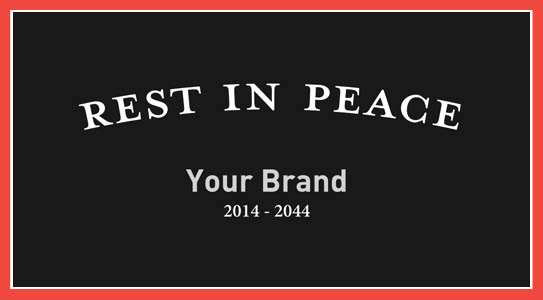
Not a proprietary exercise to my consultancy, writing a memorial speech for your brand during the Brand Foundation stage is a cruel, yet crucial step in defining your brand’s lasting values, and has been a staple in early brand development for many brand strategists. Given that those speeches are short, to the point, and always focus on only the best one has to say about the deceased, it is a great opportunity to dig deeper (did not mean for this pun to happen) into the soul and its bigger, social purpose. A brand can only leave a lasting positive impact if it cared to make a difference in people’s lives.
This is why a memorial speech is an extremely fruitful, imaginative, and most of the times rather entertaining exercise to be doing at the very onset of your brand development; and you can rarely say that about a memorial speech.
Over time we uncovered a secondary, but equally important finding during the exercise: The realization that you need to ponder about how your venture will die. And that uncovers the real long term vision for your brand: Will it be bought by Costco, improved upon and distributed to the masses? Will it become part of Marissa Mayer’s tech portfolio, giving you a nice financial push (and we don’t quite know what Yahoo! might do with it)? What is your dream, way past your 5 or 10 year business plan? If it has to end, how would you want it to end? That insight will help shape the overall business and brand strategy.
And here you thought I wanted to harm your newborn venture, while I want to do the exact opposite – watch it grow through planned retirement towards a happy ending.
The True Tech Startup Trend: Cloned Apples From Cloned Trees
Many tech startup founders pitch their project by saying ‘It’s just like Instagram, but with [filling in their differentiator],’ or, ‘Imagine Pinterest, but only [filling in their differentiator]’. Quite peculiar, most of them are located in places like Silicon Alley, Silicon Hill or Silicon Forest.
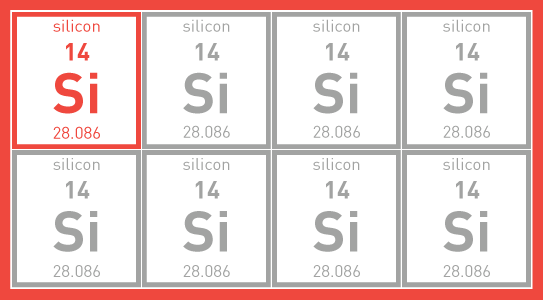
With ‘startup’ being the thing to do for many (particularly right out of college) this hot minute, it is the idea of starting something (anything really) that is often greater than the business idea in itself. Innovations turned into variations of the same, leaving the invention behind, while startup meccas themselves turned to cloned names: Silicon Alley (New York), Silicon Beach (Los Angeles’ West Side – Note: we pushed for the name Tech Coast), Silicon Roundabout (London), Silicon Forest (Portland), Silicon Hill (Washington D.C.) not to be mistaken with Silicon Hills (Austin), Silicon Border (Mexicali), Silicon Sloboda (Moscow) and many more.
Silicon Valley was named after the prosperous semiconductor manufacturers that were inhabiting the surrounding San Francisco area in the 1970’s. Today, as too many Silicon Valley clones are churning out too many Snapchat clones, it is time to remind ourselves what Silicon Valley was named after: An element; and there are no two elements that are alike. Silicon as an element only exists once. The periodic table is yours to experiment with.
Time to get creative. I can’t wait to hear about, better yet, be part of that journey.
CATEGORIES: Startup Advice Your Brand Launch: Naming
Whatever You Do To Gain New Customers, Stop.
Want to get more customers? Are you purchasing pay-per-click ads? Planning to exhibit at a conference? Rolling out some print-ad campaigns? Cold-calling perhaps? Interns acting as 24/7 Social Media Experts?
Stop whatever you are doing and think inside the box. That is, the very screen in front of you.
New ventures spend a vast amount of time and money pushing people towards their landing pages in order to get them to opt in, download an app or make a purchase. Makes sense. This is what it’s all about: Gaining Customers, Leads and Followers, quickly. The best proof of concept you can possibly get.
Yet they do not even spend a fraction of that time or money analyzing – I am not talking about A/B testing here – if that entry point actually talks the talk and looks the look.
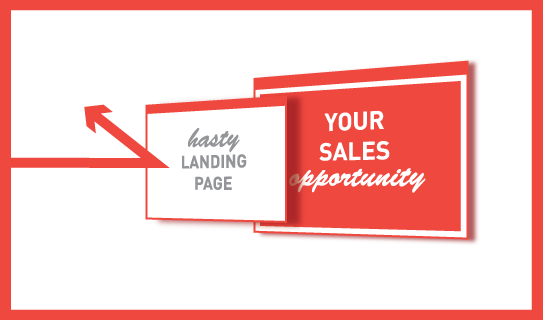
In order to attract, you have to be attractive and not just beg for clicks. I know many ad agency execs who hate seeing their clients waste tremendous amounts of money on online media buys (a dying breed in itself) that point to horribly off-brand (design and message) landing pages. They are called landing pages because that is exactly what people do: They land, and then they take off again, into any direction, just not down the purchasing funnel. Instead of being appealing entry points, those often are quite appalling afterthoughts. It’s like throwing a party and you spend all the time and money on inviting loads of very cool and attractive people, and as the day comes around you don’t even clean the house or have cold drinks ready.
If you want to get more customers, put yourself in their shoes first and work until you get yourself to click that buy, submit or follow button on your (let’s call them…) entry pages. Only then should you even consider looking for new customers ‘by entry of’ your web site, which, really, is the main entrance to your brand today.
Make that house look like it has never looked before. Polish that glossy red door and put your name on it. This is the time to shine and to let people in.
Happy spring-cleaning!
The Number One Reason Customers Will Be Attracted To Your Brand
To find out, ask yourself this simple question:
What Is Your Brand’s Scent?
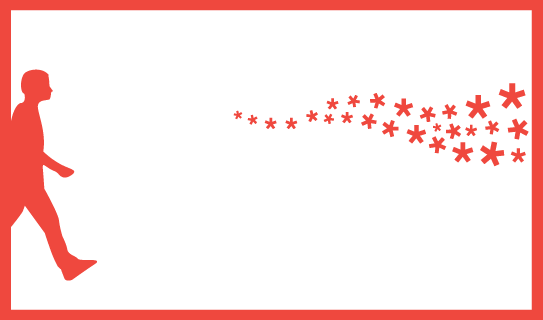
I am not referring to the overwhelming perfume infused air you have to walk through when entering an Abercrombie & Fitch store (a scented brand environment). I am talking about the metaphoric scent your brand emits to attract, distract, or utterly confuse your audience.
During a delightful call with Stuart MacDonald (Freshbooks’ CMO) earlier this week, Stuart used the word ‘scent’ when we talked about branding. It really hit home. Like animals, we are attracted to scents, in the literal and metaphoric fashion. Nike emits the scent of inspiration and innovation for athletes, Oprah the scent of belonging and community.
When thinking about your brand, and why customers will be attracted to it, think about what scent your brand has. It will make you think beyond logo, beyond copy, beyond imagery and campaigns. You will have to take a step back and start to interact with your brand from afar, as if it was the very first time you ever ‘smelled it’. I hope it smells like roses, unless roses are not really your brand.
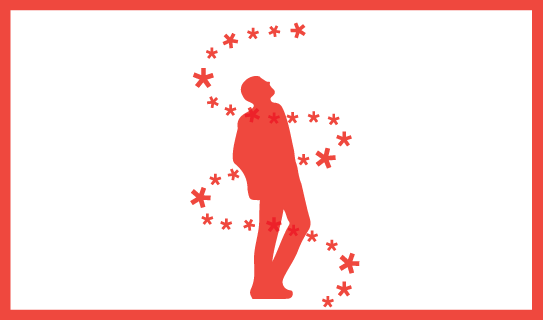
The closer you will get to your brand, the stronger and more intense (= focused) the scent will get, and once you are deeply immersed in it you will realize if you are in fact emitting the right scent altogether. It’s powerful. Try it today and let me know how it educated your actions.
Don’t Give The Customer What She Wants
Your new brand is not yours, it is your customer’s. Then let’s give the people what they want. Sounds rational, but it’s not that easy.
People do not know what they want when it comes to new brands. We do not know how to venture into the unknown with brands, we tend to seek comfort only in the familiar, and the familiar is far from aspiration or disruption. To look ahead and to launch something new you need to charter into the unknown.
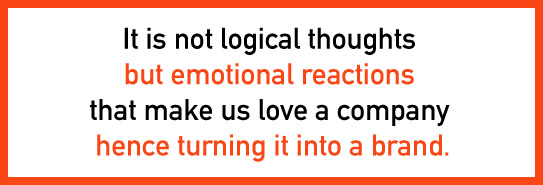
A client shared with me the other day, that they will test two variations of their new brand in an A/B test with their audience prior to deciding which they should actually go with. From an analytics point of view it makes total sense: test two brands (the logo, look & feel, voice Etc) with the audience and see which one they prefer. Yes you will confuse some, but heck, worth the data.
I strongly advised against it.
The problem is that branding is far removed from analytics. It is not logical thoughts, but emotional reactions that make us love a company or product, hence turning it into a brand. Further, befriending and adapting a new venture as a brand happens over time. Yes, you will immediately know if you need the product, you might even decide you want the product, but to fall in love with the brand, that does not happen in an instant, not in an A/B test, and, you very well may disagree with me on this, not in a focus group.
Do you think a white swoosh on bright red is a good solution for a new sugary caramel/caffeine syrup-based soft drink? Nah, we would all rationally agree that beige bubbles would visually translate the taste much better. Done. Death of the Coca-Cola brand by committee.
Brand creation by committee is not the solution. Brand creation through A/B tests is not a guarantee for success (but a sure way to confuse customers and staff). Brand building based on a solid brand strategy (research and insights) mixed with honest gut feelings is the formula for success, and for that to happen it takes a founder’s complete trust in her brand consultant and herself, as well as a boatload of courage. This might just be the reason why you see so many focus groups and A/B tests.
Rapid-Fire Brand Name Advice
On this blog I already talked about what makes a name successful and how to pick a domain name, but many of you ask if I find a fabricated name to be superior to a descriptive name, and how to best navigate the types of names that one can consider, quickly. Short and actionable, I’ll give one sentence of advice on each type of name. 3, 2, 1, go:
Descriptive
Example: Match.com
Advice: Great as it immediately conveys what it is/does – only if you will never expand your product offerings – but limiting and hard to find a sound domain name
Metaphor
Example: Puma
Advice: Not a top choice as existing connotations, domain name difficulties and Search Engine results can quickly come in the way for a new company
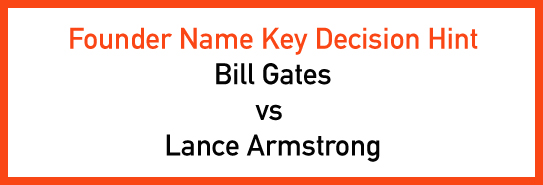
Founder
Example: The Bill & Melinda Gates Foundation
Advice: Great if you are the brand, you already have a legacy and if you are Bill, and not Lance
Fabricated
Example: FINIEN
Advice: It’s genius, of course! In all seriousness, it is a great path, if easy to pronounce and recall, and backed by a great story
Acronym
Example: AOL (America On-Line, Remember?)
Advice: A solid option to sound like a larger company from the start; only if your customers can recall your letters and if you can get hold of a reasonable domain name (sorry, three- or four-letter combos are all sold out)
Fabricated x Acronym
Example: Wanelo (Want, Need, Love)
Advice: Great option if tied to a tag line – otherwise the same criteria applies as with Fabricated names
Creative Spelling
Example: Lyft
Advice: Don’t do it, it’s pure laziness – unless word of mouth is not important to you (Wait, you spell it just like Supply but with a v instead of the u?) and you cater solely to ages 18-28
Numeric
Example: 7-Eleven
Advice: Don’t do it out of laziness (I picked our street number, easy does it) as no one will recall it – do it only if you can create shared meaning (7-Eleven: open 7 – 11, 7 days a week) or showcase value (Social 123 – easy as 1-2-3). See my post on numeric names for details.
There you go – no more excuses. Just do it, or dig deeper via our white paper, or if all fails (or you have better things to do, like starting a business) call me for help, or call us for hands-on naming magic.
CATEGORIES: Startup Advice Your Brand Launch: Naming
Your New Company’s ‘Stick’ – When Branding Helps Create And Save Your Venture
Ask yourself: Am I about to launch a product/service, or a brand?
How would you know?
You may not have a direct competitor yet, but you soon will. When the innovative, new and unique wears off, competitors will offer your product at a lower cost. How will you keep your customers from choosing their product instead? What will it be that will make your offering stick? Too many startups have to re-invent, re-brand and re-connect once they find traction – at a high cost.
If you have a unique offering combined with ‘the stick’ – the set of true differentiators, the emotional connectors that deliver from the inside out, consistently on message (visually and verbally) and on target – you know you have a brand. Having that foundational special ingredient is like a survival formula for your startup, it will make customers come sooner, faster and stay around even if they could save a few bucks elsewhere later on.
@i_mdoughboy tweeted the following last week about my consultancy’s process chart (see below): Guess where the value is? Here’s a hint – the graphic is eerily similar to a bullseye.
Imagine you are a gifted craftsman that has mastered a unique design that you developed over the course of years just to sell very few and at a high price as you don’t have the audience nor infrastructure. You created something truly unique that only you offer. After years of work, but only a few units sold, you see your design offered at a fraction of the cost at a large retail chain. It happens daily. Examples are too many to give, from apps to shoes to frozen yogurts, and all across B2B services. The only real life insurance you can have, besides a unique product/service to start out with, and its correlating trademarks, is to have that ‘stick’, those emotional brand differentiators that spread across product, service and your Brand Atmosphere. Those are hard to replicate.
If they like your product/service, they might come and purchase it.
If they love your brand, they will come and purchase it, return to it, and stay with it.
(Only read further if this hits home and you are an entrepreneur that is looking for their offering’s ‘stick’)
Avoiding the trap is hard to do for startups, being strapped thin on time and money, hence they often launch blindly, solely focusing on the uniqueness of their offering and not that of their brand. We saw this as a huge issue facing early stage entrepreneurs. Over the course of the last 6 months (based on our 12 years of experience running a branding and design agency, and with the help of writing a book on the subject) we were able to create an affordable ‘overnight’ remedy to avoid that trap. This is a huge reveal for us, which I am thrilled to share with you via this post: Meet our Resonaid™ Brand Foundation workshop, where I spend a full day with you, one-on-one working through a proven, proprietary process to find the path for your new brand to emotionally connect with your customers from the get-go and for the long term. I have one date left available this month and a few in April. Contact me via fgeyrhalter@finien.com if you are interested in learning more about this customized workshop to find the brand ‘stick’ for your startup.
PS: Yes, there is a great book entitled ‘Made To Stick.’ You should pick it up, it discusses why some ideas thrive while others die. Rather appropriate in this context.
Walking The Talk In Silicon Valley – What Mattered At The 2014 LAUNCH Festival
I spent the first half of my week in the land of the nouveaux riches and the fail-backwards-wannapreneurs, the starving startups and the über (Pun!) rich venture capitalists, the land of income gaps and the building of bridges for such; it was an experience that was well worth having and well worth sharing.
Jason Calacanis is a VC mogul, an entrepreneur, and blogger, but most important, he is a man with an opinion that he is happy to share, like most of his big-player pals. Jason built an empire, and for 3 days a year he opens it up to us. Startups attend for free, the rest of us pay our dues. Startups spend the days prior inventing and building, VC’s meeting, and then in a grande finale they sign checks. Just like the one for $50,000 to two young adults from Warsaw who looked like deer in headlights on stage, not knowing what just happened to them over the past few days; from arriving, to forming a company, to getting checks from Jason and the (rather mesmerizing) leader of the cult-VC pack, Mark Cuban (Dallas Mavericks, Shark Tank Etc) with 9,000 attendees watching their acceptance speech. They told us they will now move to the US.
On the same day that a Google glasses wearing female was attacked outside a bar (‘Glassholes’ they call them) and Mt. Gox came tumbling down, I saw a shocking amount of both, ladies wearing Google glasses and Bitcoins being freely distributed. Inside the conference grounds, one can’t help but contemplate about how the inside connects to the outside, if some of the tech ideas will connect with anyone but the developers who created them, if some of the checks written will help or hinder the growth of those companies, if the billionaires use the tech for good movement like Fortune 500’s used green-washing. Yet Marc Cuban put it the best way, and I drank his thoughts like Kool-Aid; being asked about what makes him happy, he surprisingly mentioned his role on the popular TV show Shark Tank, which could be seen as a total sellout (not that Cuban needs the implied money), he said (I am paraphrasing): “Shark Tank reaches whole families, kids to grandmas, generations of all income levels. They start talking about entrepreneurship, about ideas and how they can turn into money. The show brings the American Dream back up front and center within our society at large. It makes me proud and happy.”
At Launch you will witness a spirit of anything is possible in a fast paced environment that is comparable to a campground smack in the center of a Formula 1 race, only that hot dogs are being switched out with farm-to-table food fare and the exchange of High Fives with that of large checks. Here are the companies that took the stage at Launch, which made the biggest impact on me, and I predict will make the biggest on mankind in the coming years (None were part of the Launch competition, its winner was Connect, which is quite cool as well):
1. Google’s Ara Phone
Of all the companies you pick Google? Really? Indeed, my thoughts exactly, but stay with me here: Google showcased their Ara phone (used to be Motorola‘s prior to the acquisition) and it will disrupt entire segments and industries. Modularity meets 3D Printing, Open Platform meets Affordability, the list goes on and on. Already a staple of internet phone geek chatter over the past months, it was astonishing to see the Ara prototype being assembled on stage, click by click, snap by snap. A vision turned reality. Developer Conference is taking place this April and by next year’s Launch conference we will all be sporting one, but none will be alike.
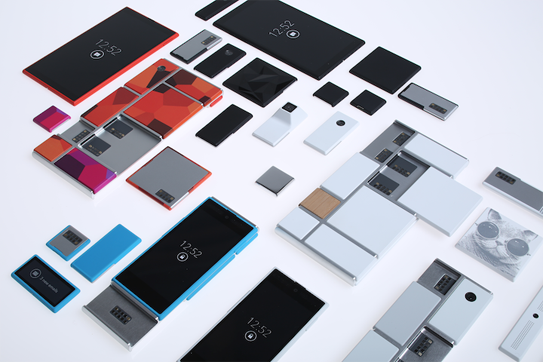
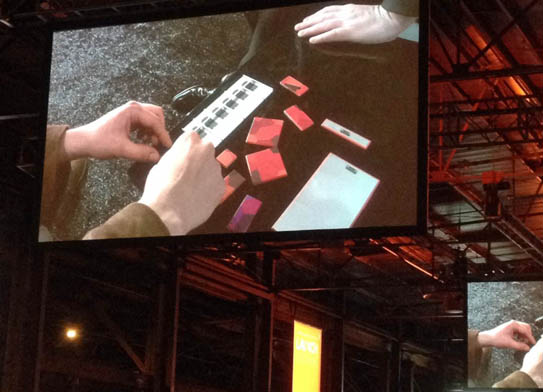
2. The Cardiovascular Innovation Institute’s 3D Printed Heart
We can 3D print a superior human heart. And that is ‘the easiest organ to bioprint‘. You should be able to get yours within the next 5-10 years. Mind, blown. The app startups that took the stage thereafter suddenly impressed less by the minute.
3. Knightscope’s K5 Autonomous Robot
He predicts and prevents crime. And he’s scary to your privacy, but there is no doubt you will meet K5 soon, and he might just save your life. Lose your privacy, have your life saved. A risk worth taking?
Below you can see a graphic showcasing 20 of the 40 companies that launched at the festival this year and (if you have really good eye sight) the money raised by attendees in the short 3 days for each, outside of the added funds during the final ceremony. Very few of them will have lasting impact, but as Jason put it prior to announcing the award winners, no one, not even the judges really know who of them will turn into the next WhatsApp, SnapChat…or Dropbox, which was not deemed worthy an award at Launch a couple of years back.
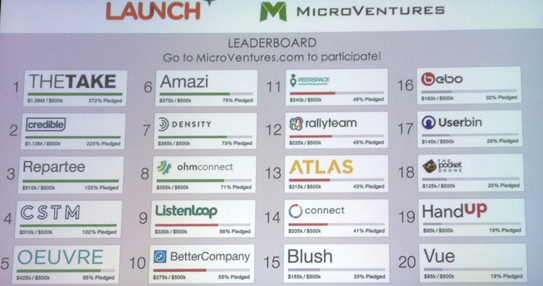 Launch walked the walk, the money talked the talk, and all of it happened while the many homeless outside the venue had no idea that they too will see the benefits of what Jason has put together. They just saw the Teslas pulling out of the lot.
Launch walked the walk, the money talked the talk, and all of it happened while the many homeless outside the venue had no idea that they too will see the benefits of what Jason has put together. They just saw the Teslas pulling out of the lot.
See you next year at Launch. Call me on my Ara phone to Connect.
CATEGORIES: Blog Startup Advice
Tackling Your New Brand’s About Page: 4 Tips On How To Say Less, Edit More, And Make It Resonate
I was born in Austria. English is my second language. Yes, I write a lot, but I do it because I want to share my expertise, not because I believe that I am a great writer. Yet today I set out to blur the lines of copy writing, branding, enthusiasm, content strategy, your target audience and content overload. Launching your brand puts an emphasis on the About section of your web site, no doubt about it. Even if you have a video and to-the-point messaging on the Landing Page(s), the About page will be sought-after. It needs to explain the following in a swift manner:
- What you do (Mission/Product Or Service Intro)
- Who you do it for (Target Audience)
- How you differ (Differentiators)
- Why I should care (Connect Emotionally/Value Proposition)
- What I should do next (Call To Action)
That’s a lot to convey on a single page and therein lies the problem for an enthusiastic entrepreneur who writes this important piece of content in a stream of consciousness (it is after all the subject you know best), then quickly proofs it, and by the push of a button publishes it. Rarely do they look back. Yet another item checked off the busy to-do list. Then the journey of marketing and metrics hits in and the About page, long forgotten, is like ‘a ghost employee’ in a well functioning company; it lives on yet it should have been let go and replaced a long time ago.
I know this feeling well. I see it on a nearly daily basis with our new clients, but I also fell victim to it myself. Here are my top 4 tips on how to go about deriving your About copy:
1. Find A Time And Place
It has to be right. You can’t just block off an hour on your busy calendar. It has to be more like that moment when you drive to the beach to just sit and breathe and think big thoughts. Make the time for that moment and don’t put a time limit on it. For myself that moment arrived during a 12 hour flight after I have answered ‘all’ E-Mails and there was no WI-FI for new ones to trickle in. I watched the Steve Jobs movie (Inspiration 1), had a glass of wine (Inspiration 2), the cabin lights went out so everyone could sleep (I was in Coach – Inspiration 3), and I knew if I started writing now that I had hours and hours to fine tune and contemplate. And so I did – the time and place were right. Best of all, even if I wanted to, I could not just push it live as I did not have WI-FI, so it forced me to sleep over it and make even more tiny edits when ‘back on the ground.’ It took me 3 hours to write.
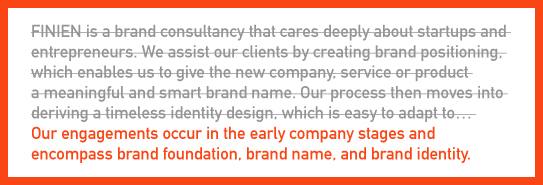
Edit, edit, pause, then edit some more.
2. Think In Words, Not Sentences
Words should not come easy (Ask F.R. David, he knew). If they do, consider it a brainstorm exercise, then work on a synopsis of that copy. Don’t cut paragraphs, don’t review sentences, dive deeper and focus on it word-by-word. In the end your About copy should be thought of as a lineup of tag lines, because in a tag line every word counts, has meaning, adds to your brand story. Think of each word as a strategic component to the whole.
3. Read It Like They Would
Once you feel you phrased it in just the right way, make sure it will resonate with them. Sounds logical, hence easy, but it is one tough role play: Write in an emotional and enthusiastic manner that conveys your brand’s soul, but then read it from the perspective of your target audience. It helps when you created target personas, that way you can read pretending you are that specific person. If time allows, run it by your target audience and conduct a mini focus group, or even A/B testing of different About pages, to see what sticks.
4. Edit, Then Edit Again
Make it as simple as possible. Make it as short as possible. If you need to, add links to further content below your CTA (Call To Action). No one reads a long About section. No one. Rather go through steps 1-3 and then edit it down again and have something your audience will actually be compelled to read, because it is short and approachable. This is about getting them excited to keep going further, to click deeper, it is not the page that needs to convey everything, but ensure it has the 5 components listed above embodied.
In a study of user tests it was discovered that users with higher literacy levels also fared better on web sites written for a lower level literacy audience. So keep it brief and keep it simple. I guess I should go back and edit this post, but I don’t feel too bad keeping it this length as someone just released the book ‘Brief: Make a Bigger Impact by Saying Less;’ it spans 256 pages.
CATEGORIES: Startup Advice Your Brand Launch: Digital
What Is An Entrepreneur’s Biggest Pain Point When Launching A Brand? The Answer May Surprise You.
Working with startups on developing new brands on a daily basis, we had a pretty good idea about our clients’ key struggles, but we reached out to entrepreneurs purchasing our book and asked them what they perceived their biggest hurdles to be. Here are their top 3 pain points:
1. Positioning my new brand (46%)
2. Developing a successful digital presence (21%)
3. Naming the Brand (14%)
Are you surprised?
I was.
Not about the fact that positioning is the most important component of a brand launch. After all, it is the one that takes the most out of entrepreneurs as it requires a refined mixture of many diverse skills – creativity, industry insight, foresight, process and honesty (among others), and it is something that is very hard to create in a silo. What did surprise me was that entrepreneurs see the importance of positioning so clearly and that they are humble enough to acknowledge the DIY approach might not suffice when it comes to this aspect of their brand launch.
Positioning is at the core of brand development, it forces you to answer the question Why, long after the questions What and How have been settled in your mind and you have decided that there was a need and you had the means to start that new business, or create that new product. The direction of the business has been set, but the direction for the brand has yet to be created (and synced). I believe most entrepreneurs start diving into positioning (and the overall creation of the Brand Platform), too far down the line, which adds to the fact that 46% of our respondents see it as their core branding issue.
What is, or was, your biggest pain point with your startup? Do you agree with our readers’ responses?
If you are struggling with positioning, we created a white paper on the subject (free download).
CATEGORIES: Blog Your Brand Launch: Brand Strategy
